By Marie Harrowell
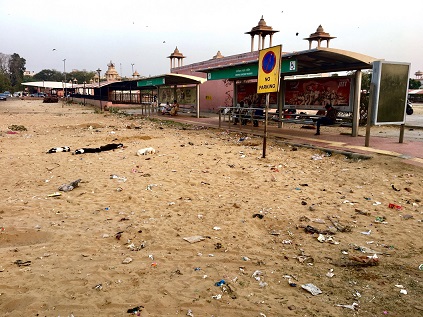
Travelling in India you are inundated with the unfamiliar and the unexplained. Surprising sights quickly become the norm as you adapt to new ways of doing business and getting around. So why is it that I cannot keep from being shocked by the waste left lying in almost any piece of open ground? Particularly in rural Rajasthan, it is impossible to miss the large amounts of waste which litter the side of the roads and streets. Plastic items, food waste, scraps of metal and chai tea cups are some of the common items which are seen on the road. Ideas and attitudes towards public space and waste in India have captured my interest. Why is it that there seems to be such a difference in the social attitude to waste and its disposal between India and Australia?
The twin absences of education and law enforcement certainty play a role. According to a number of studies of rural areas in Karnataka and Chennai, environmental awareness is low among the residents and education opportunities in environmental sustainability are rare. It is also common for the local rural residents to leave waste in public areas knowing there are no penalties or enforcement of waste management policies.
Alongside the lack of awareness and enforcement, there is an interesting cultural twist: dumped waste can be viewed as a religious offering. It appears that rubbish on the sides of roads is often thought of as an offering to the cows that roam freely around the streets, towns and villages. The majority of the population in India is Hindu and consider cows to be holy. The discarded waste is regarded as a food offering for the animals. This belief system turns waste left in public into an act of communal reverence.
In principal, the idea of providing the cows with food scraps might once have worked well as a simple form of recycling. The problem now is the increasing amount of plastic in discarded waste. If eaten, plastic poses considerable risk for the cows, either killing them or causing their milk to become toxic. The rapid increase in population has also meant that there are much larger proportions of this trash, which has meant that there is excess waste not even touched by the cows.
Are our Australian attitudes to waste really that much more evolved? We certainly are wealthy enough to have garbage collected and transported to large dumps. Out of site out of mind, we probably think as little of what happens to our waste once we have thrown it into a bin as does the Indian villager. I see waste disposal as a critical issue for a country such as India. As this waste builds up it can cause environmental degradation and contamination of essential natural resources so essential to human well-being.
Shopping Across India
By Chantal Young
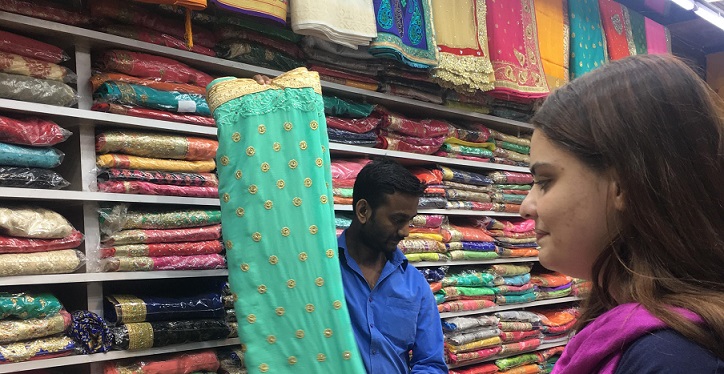
Okay let’s face it – I love shopping. Throughout this field school, if there is a shop to visit I’ll be there. India provides a wealth of unique handicrafts, leather goods and beautiful textiles and I have a collection of mementos sourced from diverse locations such as entrepreneurial artisans in Dharavi slum to women’s collectives of northern India. Having worked in Australian retail throughout the duration of my undergraduate studies, I also have a degree of fascination and affinity with the shopkeepers I have met along the way.
Recently in Ranthambore, an area famous for tiger safaris, I visited a handicraft market adjacent to our hotel. Here I got talking to Ashok, the man who runs the stalls. Chatting over beautiful silks we began comparing work conditions. We both cut fabric for a living, just 10,000km apart, and it turns out that while I earn $20/hour part time, working a maximum of 10hour days, Ashok works 14hour days earning just 7000 rupees a month, or about $140. The shop was lovely, packed with fabrics and gifts, and I managed to spend nearly his month’s salary in an evening. This really drove home the issue of India’s income challenges in a very personal way.
In seminars, lectures and field visits a major theme has been wealth and poverty in India, and the vast economic inequalities. Currently, India is said to be the second most unequal country in the world, with the richest 10% of Indians owning 80% of the wealth. This trend is increasing every year, with around 30% of the population living below the poverty line.
Market liberalisation since 1991 has encouraged traditional skills and trades to engage in entrepreneurship within the capitalist market to increase income, and the results of this were evident in several of the handicraft markets we have visited throughout the trip. Many of these businesses focus on positive social change, and increasing the standards of living for the poor and marginalised. One example is Bunkaar Textiles, a rural woman’s collective weaving and embroidering scarves for sale, or Dharavi leather goods which sells bags, belts, and wallets made by leatherworkers in the Mumbai slum. While these initiatives are a great start to secure income streams for groups of people living below the poverty line, it will take larger initiatives to really transform lives across the nation through income and employment.
In 2005 the government established the National Rural Employment Guarantee, a progressive act which aims to guarantee the ‘right to work,’ and enhance livelihood security in rural areas by providing at least 100 days of wage employment per year. In 2014 the World Bank described the program as a ‘stellar example of rural development’ and it appears to be ‘slowly but surely’ making a positive difference in the lives of the rural poor. Yet the government still lacks a social welfare payments scheme which would see the unemployed or underpaid guaranteed income payments to meet basic needs. Instead, there is a complex array of subsidies and grain rations to households sitting below the poverty line. On our Ranthambore safari we did not manage to see a tiger, so Ashok gave me a tiger postcard at the store. Just like this ‘consolation prize,’ allocation of grain rations comes as a welcome but poor second to monetary welfare payments and the financial freedom that accompanies them.
The issue of how best to deal with income inequality and poverty are not isolated to India, and back in Australia we debate over the relatively low minimum wage of retail, arguing it is not enough considering the high cost of living in Sydney. But visiting India and interacting with the retail industry here has put this in perspective for me, and I am extremely grateful for the employment standards and welfare systems we do have.
As our tour guide in Dharavi said, ‘change is the only constant in India,’ and everything is changing very fast. A new middle class is burgeoning, and I look forward to the day when these inequalities in India can be reduced and Ashok does not need to work 14hour days to make ends meet. In the meantime, shopping in India certainly has been an eye opening experience speaking to many of the income issues facing the nation today.
Transport Worries
By Sam Lehmann
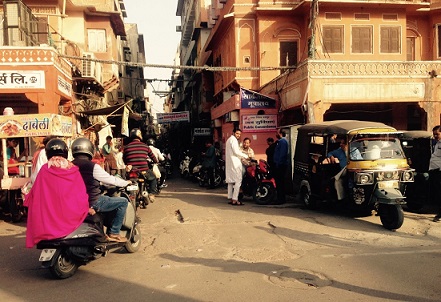
The most common form of vehicular transport in Mumbai is the scooter. The number of two-wheelers resembles a swarm of bees. The noise these vehicles generate is minimal, though horns are perhaps the most common sound you hear in India. In addition to scooters, auto-rickshaws, cars, bicycles, animals, buses and trains are common modes of transport. Which mode of transport a person uses is, to a large extent, determined by their economic capacity.
Scooters are the most affordable of any motorised private vehicle available in Mumbai. Purchasing a scooter will set the buyer back anywhere upward of ₹40,000 (Indian Rupees) or about $800 Australian dollars – a new ‘TVS Scooty Pep Plus’ sells for slightly more than ₹40,000. The TVS is specifically marketed to the needs of the average budget conscious Mumbai resident. It is low powered but fuel efficient. The rider will be able to ride 300 or so kilometres on a single 5 litre tank of fuel. And, with fuel costing roughly ₹80 ($1.50) per litre, ongoing costs are minimal. However, due to the relative affordability of scooters such as the TVS, the number of scooters in Mumbai is becoming problematic.
Between 2006 and 2016 the number of scooters on Mumbai roads grew from 790,000 to 1.6 million. This is a sign of increased wealth. During the same period, the Maharashtra state government built only 2000km of new roads, in a city spanning more than 600 square kilometres. The growing number of scooters on Mumbai’s roads, congestion and pollution are all troubling issues. How will Mumbai, and India more generally, cope with the inevitable growth of two-wheeled motorised transport that comes with economic growth?
In the recent national budget, the Indian finance minister Arun Jaitley outlined the central government’s plan to spend more than ₹50 lakh crore ($90 billion) on transport infrastructure. The allocation of such a massive amount of money will make inroads into the growing transport problem. Of this $90 billion, a large proportion is expected to be spent developing transport infrastructure in and around “areas of economic importance” ( 2018 Budget, page 4). This bodes well for Mumbai so long as the planned funding is rationally spent.
The 21st century will reveal many development challenges for the people of Mumbai. The need for equitable modes of transport is only one of these. It is crucial that viable transport systems are developed to cope with an already massive, but growing, population. Though scooters may well be a feasible and affordable mode of transport today, the presence of an additional 1.6 million scooters in Mumbai would create havoc in an already stressed transport system.
Grass-Root Oaks
By Mathew Friedman
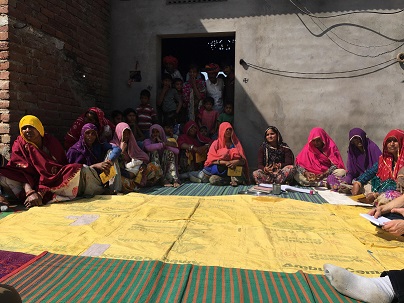
“I’m not sure how you want to phrase this, but can you ask whether men feel threatened at all?”.
I can tell from Dr Chetan Choithani’s widening eyes that the challenge of asking something like this to the group of around a dozen women, with some men and children lurking in the doorway, is going to require more than a linguistic translation.
We’re sitting with one of the eight women’s self-help groups in Kanwarpura, a village of around 1,000 inhabitants. Our guide here is a representative of SRIJAN, the NGO that helped set this group up seven years ago, and continues to support it.
“I might… take another one whilst I figure out how to word that” says Chetan, before moving on to a question about SHG structure. Fair enough.
I am, however, curious. We have spent the first half of this field school hearing about the manifestations of a deeply patriarchal society, and yet here, in rural Rajasthan of all places, is a group of women who talk like they’ve never heard anyone tell them not to. It’s a total misnomer that women’s empowerment leads to the opposite for men (a message that the global North needs to learn as much as anyone), but I can’t help but think that this is all too amazing to be true.
Because it is truly amazing. This SHG of ten women has built up a savings stock of 60,000 rupees (around AUD$1,200), which they lend to one another to purchase livestock, repay outstanding loans, cover medical expenses, and build infrastructure like wells. The Agriculture and Development School, run by this and three other SHGs, claims responsibility for doubling crop yields in four years through training and soil testing. The local government school is now preferred to private alternatives because pressure from the Village Development Committee, a council of 16 women representing all the village SHGs, have made teachers attend their classes. Kanwarpura has 24/7 electricity, reliable clean drinking water, toilets in every inhabited house, relatively reliable government services, and a corruption trial against an official that clearly underestimated what he was up against.
I am aware that as a group of foreigners, the goal is to impress us, and that the SRIJON lens is necessarily limited. For example, we walked through a neighbourhood belonging to a group from a ‘scheduled tribe’ but didn’t speak to any of its inhabitants, nor to any woman excluded from the SHGs, or any officials. Nor, for that matter, to any men.
“Men don’t feel threatened,” comes the eventual translation, with a very logical explanation. “They encourage these women. It’s a good source of income and credit when the family needs live stock or something like that. Once they saw that the SHG worked, there’s a lot more respect”. The women nod along.
Even taking all of the successes mentioned above with a pinch of salt, it’s clear these women are respected, by men, none of whom tried to speak for them, both public and private banks, who have lent the Manrag SHG four times their savings stock, but most evidently by themselves. These women probably would have had less food and more work than their brothers, little education, and would have had to relocate to an entirely new village during their arranged marriages to become the lowest with the hierarchy in their new families, almost all of which would be in the lower social and economic echelons within their village. Yet these women sat in front of us with studiously kept account books, interrupting one another in their excitement to discuss financial, social, and agricultural strategies.
This model for development is not perfect, and hardly a drop in the ocean of India’s 863 million-strong rural population, but it does one thing brilliantly: it recognises the amazing resource that already exists in all communities. It’s well documented that women are the key to successful grass roots development, and with supportive institutional structures, room to grow, and just a little self-belief, these women seem to have grown like oaks.
Invisible India
By Laura Stewart
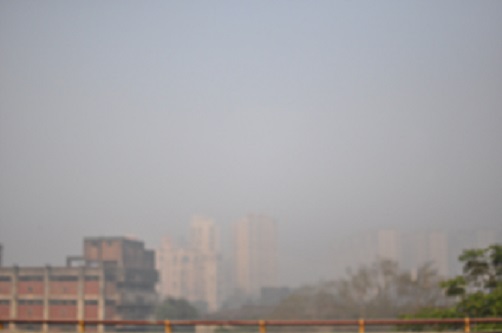
India has a population of 1.32 billion people. Homelessness, gender-based violence and malnutrition are part of the national story often not told. In the midst of such a large population many are forgotten, left to fade as if they had never existed.
In Mumbai it is a rarity for the smog to clear enough for you to see more than one layer of the city. Our gaze is always obstructed. As we begin to study the city, its institutions, and its history, it becomes apparent that this is a nation of invisible people, a nation of people we chose not to think about, chose to ignore.
As a western woman arriving in the Indian context I initially viewed invisibility as a problem. Visibility and recognition is necessary for social change. In India, however this must be rethought. Our guide in Dharavi moved to Mumbai because he wanted to disappear. Involved in a love marriage invisibility meant he and his wife could avoid being targeted by the police, dragged in for questioning, and, in more extreme cases of these love marriages, killed.
In Rajasthan as well I was faced with this invisibility-by-choice. Many women chose to cover their faces when in public. For a western woman such a practice is often interpreted as oppressive. In India, where violence against woman is prevalent, it is a more understandable choice. If you are a woman, too much negative attention from the opposite sex, or those in power, can have devastating consequences. Invisibility, in this context, provides a kind of independence, where no one knows who you are and your actions in public are less likely to lead to attract unwanted attention. Invisibility provides women protection, but it is also enforced by an oppressive system.
For many, however, invisibility is not a choice. Slum dwellers are ignored and relocated in never ending attempts to erase them from the landscape of the city. For those living below the poverty line, or on the streets, a unique identity number is crucial. Without formal documentation people are not able to access health services, social services, or rations. In Australia our passports, official papers and tax file numbers allow us to be seen in a thousand ways we never think about, but in India it is often those who need this visibility the most who don’t’ have it.
More concerning than those we are forced to ignore are those we choose to not to see. As a young child knocks on the window of our bus, attempting to sell us some form of plastic goods, we avert our eyes, finding it easier to ignore than deny. As a woman begs us for food we turn away. The truth is with so much poverty we cannot bare to see it all. To function we learn not to see.
One solution to the risk of individuals fading completely into to smog is to form groups. A collective that votes together is more likely to create change than an individual. However, sometimes, these groups become a vehicle for political exploitation. When you have a leader telling you how to vote your voice begins to disappear along with your identity. You are no longer an individual, but a member of a community – a Muslim, a Buddhist, a women, or BPL (living below the poverty line). You become a number in a voting bank. Or worse, you are ignored altogether. You are invisible because you remain only one in 1.3 billion, conceivable only as a statistic.
Train Travel: A Site for Reflection and Learning
By Holly Fraser
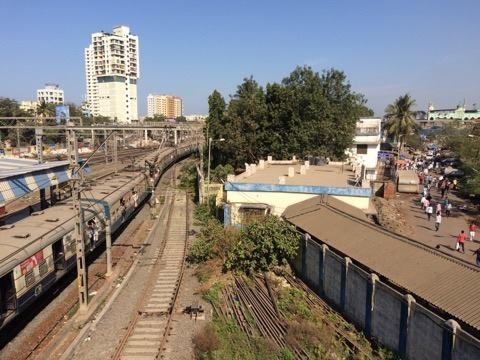
One of the most striking features about Mumbai for an Australian visitor is the amount of people. With an estimated population of 22.5 million and growing, Mumbai is currently the most populous city in India. To put that into perspective, it is nearly equivalent to the entire population of Australia! An integral part of any major city such as Mumbai is the transport. Throughout our study tour of India so far we have experienced various modes of transport including buses, taxis, rickshaws and the train. Catching transport can be a mundane activity, but it reveals a lot of interesting things about a place.
Just when I thought I had left the train woes of Sydney behind, I was confronted by more chaos but on a whole new scale when I arrived at a suburban railway station in Mumbai. It was peak hour and there were streams of people walking, shouting and shoving in all different directions. As the trains pulled up to the station they were packed with people hanging out the open door carriages. There were even people jumping off the train and trying to board before it had come to a stop. It was not hard to see why the rail network of Mumbai is known as the lifeline of the city.
Every day over seven million people in Mumbai travel on the train and for many it is a necessary way to reach their place of employment. However, as we have been made aware through our lectures and course readings, it can often be a safety issue for women. Seeing train carriages reserved for women only, a relatively new initiative in Mumbai, really re-enforces this. Any change that enables women to access employment is a welcome change in my opinion, but at the same time, it may be a band aid solution to a much larger societal problem.
Despite having train carriages dedicated specifically to women, there appeared to be far more men than women waiting to board the train. This observation is perhaps not surprising given that in a lecture on employment we learnt that there were less women employed in urban areas than men. It also reflects our knowledge of the high number of women not in the labour force, which includes those engaged in unpaid housework and care duties.
The train was not only a method of getting to work, but for others it was an important means of employment. Inside the train there were people making their way through the carriages selling small goods. Outside the train, there were people collecting rubbish distributed across the tracks. As I learnt from a local, these people are known as rag pickers. Their survival depends on selling the plastic for just 4 rupees a kilogram to the local recycling industry. Both the sellers on the train and rag pickers on the train tracks are considered to be part of the informal economy, which as I recently learnt on this field study, comprises a massive ninety-four percent of India’s labour force.
Although a fairly short train ride, upon reflection, it speaks to the themes we have been learning about over the past week such as urban growth and development, women’s issues and employment.
Smart City? Or Not So Much…?
By Jade Lisbin
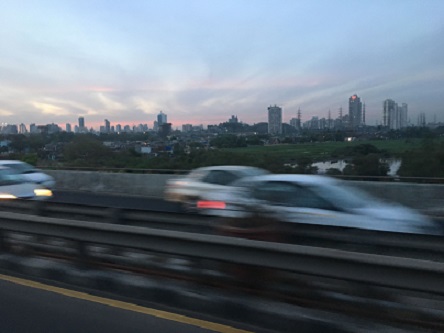
Only 31 per cent of India’s population lives in an urban area. But this amounts to 400 million people. 23 million people live in Mumbai alone. With this exorbitant number of people, I wonder, how can technology be used effectively to improve the sustainability of a city, particularly a city like Mumbai?
In recent times, new cities in India have been built to replicate those in rich countries and incorporate technology. These are called ‘smart cities’. A smart city is generally described as optimising the use of Information and Communication Technology to monitor and maximise efficiency and increase the safety of all aspects of urban infrastructure whether that is schools, transport systems, shopping centres or waste management systems. The aim is to minimise resource consumption and costs in an attempt to make the city more eco-friendly and sustainable. In theory, this sounds like a great idea, right?
The problem with this model, as we learned from one of our Professors at Tata Institute of Social Sciences (TISS), is that rather than trying to improve an already existing city, private developers and consulting companies have started creating new cities on ‘uninhabited’ land. With this, comes environmental degradation, political corruption, further social exclusion and a whole realm of other issues. I can see similarities between this approach and the dominant consumer lifestyle in which it is now easier to buy a new product rather than fix an old one. This same approach is taken to the evolution of India’s ‘smart cities’. But it comes at a cost.
Lavasa is an Italian inspired, privately owned town built on the model of a smart city a few hours from Mumbai. It demonstrates many of the issues we have been learning about such as locking out the poor while creating new homes for the rich. Lavasa is an extreme example of the approach to urban planning. But perhaps there are alternatives. Rather than creating a whole new city, investment would be better focused on improving and rehabilitating local development plans within already existing cities.
From an ethical perspective, I find myself wondering why was it is okay for countries in the global North to use all the resources they like while putting pressure on countries in the global South, like India, to limit their resource use.
How do you envisage the future of India’s development? Do you see more ‘smart cities’ popping up around India?
Slum Tourism: An Ethical Dilemma
By Ben Robinson
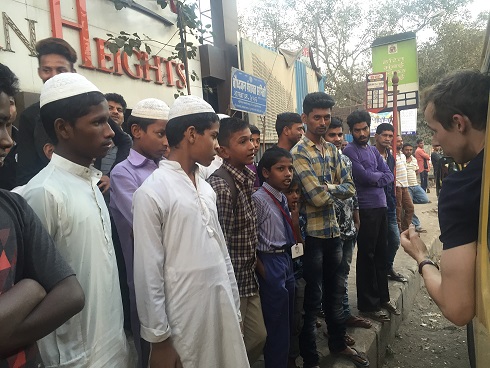
“The locals are used to it. The main benefit is for tourists who change their perceptions” claimed our tour guide, Daksh, as we walked through the winding alleys of Dharavi.
On Sunday, I went on a paid walking tour of Dharavi, along with members of our group. Dharavi is India’s biggest slum with one of the highest population density in the world. In the week leading up to the tour, and since, there has been lively debate about the ethics of slum tourism. On one hand, there was a desire to see what we had been learning about in class, while also potentially benefiting the local community by providing funds to tourist operators. On the other hand, there were concerns it could be voyeuristic, invasive, and an aestheticisation of poverty. This raised a number of questions about the appropriate role of travellers within developing countries, and where the line lies between seeing things ‘first-hand’, and being intrusive.
The tour itself was informative and engaging. We were first taken through a commercial area, surveying a number of leather, textile and pottery industries, before going to a residential area then a local school, where 80 per cent of the profits of the guided tours are sent. Apart from small children who ran up to us, our interactions with locals were passive and detached. As one of many wide-eyed tour groups going through that day, there was a feeling of indifference toward us. Daksh, our tour guide, was excellent, but I left the tour wondering: was that experience necessary to get a holistic, balanced picture of what life in Dharavi is like?
I think part of our preconceptions about informal communities is formed because of the language we use to describe them. The terms ‘slum’, ‘informal’ and ‘squatter’ are problematic and negative, defining urban life in terms of a terms of a deficit. In economics, the informal economy is that part of the economy not accounted for in national accounts. The discourse of informality is framed as the ‘other’ within the formal economics framework and formal urban planning processes. But there is no sense in which informality precedes formality. Cities are built from informal processes as much as ‘formal’ ones. In India, 93 per cent of the economy is ‘informal’ and Dharavi has an estimated annual turnover of $1 billion.
I think the popularity of slum tourism, both in India and around the world, is also linked to a trope within western culture about the ‘authentic’ traveller who visits ‘exotic’ places and ‘gets off the beaten track’. Tourists construct a humanitarian Self through their engagement with suffering in developing countries. I’ve often heard stories where tourists present their travels as essential for coveted experiential knowledge while depicting locals as the true beneficiaries of the tourists’ self-discovery. While this may not have been exactly the case for our group, as we are here on a study tour, I think these cultural narratives do affect us.
All travel involves an element of voyeurism. We enjoy seeing new places and we grow from experiences that broaden our understanding of the complexity of the world. But reflection is needed when there is power dynamics between foreigner and local, when an experience is passive and observing, rather than active and mutually engaged.
There may not be definitive answers for Dharavi, or slum tourism generally. I think this depends on a balance between the actions and intentions of tourists, the views of locals about foreigners coming into their homes, and how the tour company operates within the community that they are profiting from. But, as a foreigner, I think there is a responsibility to be cautious, reflect, and be aware of the spaces you occupy.
Young India and the Pressure to Succeed.

I come from a Bangladeshi family and have always appreciated the family and community aspect of South Asian culture. This has given me a support network, spanning the globe, of extended family and friends who are genuinely interested in my wellbeing. But close community connections bring with them a number of expectations. For some young Indians family and community pressure has a devastating cost.
Youth suicide rates are higher in India than many other countries. Every year, 30-40 young people out of every group of 100,000 decide to take their own lives. Young people between the ages of 15 and 29, who have so much to experience, to love, to learn, have their lives cut short. One of the reasons behind this is family pressures.
According to National Crime Records Bureau (NCRB) data, 2015 saw 43,852 young Indians take their own lives, with almost 50 per cent of these deaths attributed to family or societal pressures. These pressures take many forms: secret love affairs, failure to marry, and even failure in exams. Notions of success have in many ways imposed unrealistic expectations on a generation that is struggling to compete in an increasingly hyper-competitive India.
Every year, millions of young men and women enter the job market, competing over the limited number of ‘regular’ jobs on offer. Only around 10 per cent of new jobs fall into the formal or organised sector. This has led to a phenomenon described by some scholars as ‘timepass’ where students remain in tertiary education for years while searching for employment. But as disappointment turns to apathy and discontent, this inability to secure to employment and marriage can lead to distress and in the worst cases suicide.
In a country where almost half the population is under 30, a ‘demographic dividend’ is expected to be a great boon to the economy. But the conditions of extreme competition and a culture of family and community expectation is having a terrible impact on many youth. Investment in mental health facilities are urgently required to address this national crisis.
Women and Public Spaces
By Myra Opdyke
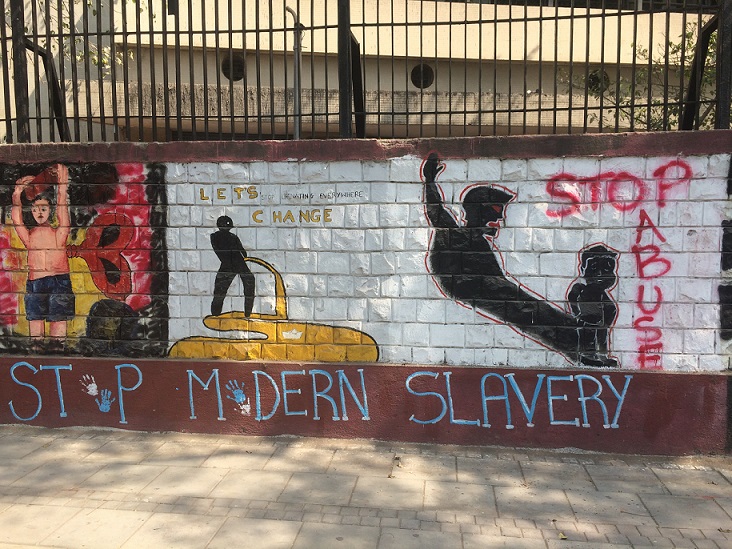
Two things have surprised me during my time in India: men urinating in public, and the lack of women in public spaces. Travelling around, I have found myself in places where groups of two or more men are out with their friends. But until I got within a day’s drive of Mumbai I had not seen groups of women out with their friends. When I first came across a group of women out together, it wasn’t a group of two or seven, but a group of over twenty… safety in numbers, I suppose.
However moving in such a large group is not always practical, which brings me back the issue of open defecation. In class we have been learning about many aspects of Indian society, particularly the complex interactions of caste, class and gender and how they shape people’s individual agency. I have been particularly struck by how open defecation is a common practice in many parts of India. This means that women often wait until nightfall to relieve themselves. Under the cover of darkness they walk out of their villages and into the fields. But this can be a very dangerous activity. Cases of rape are common.
In some areas, public awareness about the health impact of open defecation is on the rise. One group of women have begun a movement whereby they refuse to marry a man unless there is a toilet installed at his house! Sounds like a great idea. I can’t help wondering, however, whether this is a bargain that most women are able to make. India, as we have been learning, is a deeply stratified society and women are rarely able to make such claims against prospective bridegrooms. When dowry deaths number in the thousands each year, it is hard to imagine that women are in a position to negotiate sanitation facilities.
When I arrived in Mumbai from my Northern travels, I was suddenly in a different world. It was a strange combination of the India I had seen so far, mixed with British colonial buildings and women walking around freely. In some ways, I felt like I could almost be back in Sydney. It is the smells that set Mumbai apart. For a stretch of half a block, you may be smelling spices, flowers and fruit. But in a moment, you find yourself suddenly inhaling the smells of urine, defecation, and rot.
In India, a city can feel foreign compared to the surrounding rural areas. While some women in the city eat at fine dining restaurants, others are risking their lives as they walk to a field late at night. On this peaceful evening, gazing out of my seventh story window as the sun sets over the slums, greenery and multi-story buildings nearby, I can’t help but wonder how the women of Mumbai city are living. I wonder how their different backgrounds have converged to bring them here, and how the city will treat their daughters.

